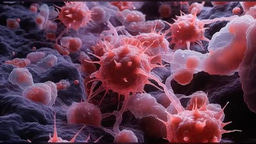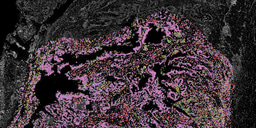Same Same but Different: Exploring the Rainbow of TP53 Mutations
Published in Bioengineering & Biotechnology, Cancer, and Cell & Molecular Biology

A CRISPR View on the TP53 Mutation Landscape
The tumor suppressor gene TP53, encoding the p53 protein, is often described as the “guardian of the genome.” By regulating a continuously growing network of cancer-relevant pathways, including cell proliferation, senescence, and apoptosis, p53 plays a prominent role in preventing cancer. Unsurprisingly, mutations in TP53 are found in about half of all cancers. Yet, despite decades of research, the functional nuances of its over 2,000 known missense mutations remain an unresolved challenge.
Each TP53 mutation carries a unique impact, altering p53’s tumor-suppressive functions in ways ranging from subtle changes to severe dysfunction. While the ten most common hotspot mutations are well-studied, they account for only about 30% of cancer cases, with the remaining 70% involving rare, poorly understood variants. Despite this diversity, clinical practice often reduces TP53 mutations to an oversimplified binary classification: wild-type versus mutated, without distinguishing between the vast array of mutations. This lack of granularity fails to reflect the nuanced functional impacts of individual mutations, hampering our ability to predict the clinical consequences of these mutations, leaving critical gaps in cancer diagnosis, prognosis, and treatment.
To overcome this limitation, we applied CRISPR-based saturation genome editing to systematically analyze 9,225 TP53 variants at physiological expression levels within their native gene-regulatory context. Covering 94.5% of all cancer-associated missense mutations, this approach provided an unprecedented high-resolution view of their functional impacts.
Key Findings: Beyond the Hotspots
1. Pathogenicity Prediction
We systematically compared the functional impacts of TP53 mutations identified in our screen with variant classifications in publicly available mutation databases, such as ClinVar and COSMIC. Mutations we identified as functionally disruptive closely aligned with those classified as pathogenic in these clinical datasets, while mutations with milder functional effects were consistent with benign or uncertain classifications. This high level of agreement highlights the accuracy and robustness of our approach, reinforcing its value for clinical variant interpretation in genetic counseling and clinical decision-making.
2. Partial Loss of Function
Our analysis uncovered numerous mutations that impaired p53’s tumor-suppressive activity without abolishing its function fully. These partial loss-of-function variants were significantly over-represented in cancer samples compared to silent mutations, supporting their tumorigenic potential. Nevertheless, many of these mutations had previously been (mis)classified as benign due to their near-wild-type activity in overexpression systems. By studying these variants within their physiological genomic context, we uncovered subtle yet clinically meaningful deficiencies, emphasizing the critical importance of evaluating mutations in their native environment. These findings underscore the need to reclassify these mutations as potentially pathogenic, ensuring they are accurately accounted for in clinical assessments. Notably, several of these variants exhibited temperature-sensitive behavior, making them promising targets for p53-reactivating therapies such as drug-induced refolding strategies.
3. RNA Splicing Disruptions
Some mutations impacted RNA splicing rather than directly affecting protein structure or function, leading to the production of aberrant transcripts. These mutations, including both missense and synonymous variants, disrupted normal splicing patterns, resulting in defective transcripts that were degraded by nonsense-mediated decay. As a result, these mutations caused a complete loss of p53 protein production and function. By introducing mutations directly into the TP53 gene in its natural context, our study uncovered this previously underappreciated mechanism of loss of function, broadening the scope of TP53 dysfunction beyond protein-level changes. Additionally, our findings demonstrated the feasibility of correcting splice-disrupting mutations using splice-switching oligonucleotides (SSOs), opening potential therapeutic avenues for restoring p53 activity in these cases.
4. Absence of Inherent Gain of Function
Mutant p53 is frequently implicated in promoting metastasis, chemoresistance, and other oncogenic behaviors through gain-of-function (GOF) activities. However, our study found no evidence of GOF effects directly after mutagenesis. Interestingly, GOF properties like increased migration, invasion, and metastasis emerged after cells harboring the R175H hotspot mutation were propagated for several months in mice. This emergence was associated with elevated expression of the mutant p53 protein, a factor previously recognized as critical for GOF effects. While our investigation focused solely on the R175H hotspot mutant, these results nevertheless support the broader concept that the manifestation of GOF phenotypes requires further genetic changes or environmental factors that enhance mutant p53 expression levels. Collectively, these findings challenge the notion that mutant p53 inherently carries GOF properties, especially in early stages of tumor development, and refines our understanding of when and under what conditions these effects arise.
Redefining the TP53 Paradigm
By systematically mapping the functional impact of TP53 mutations, our study provides a deeper understanding of the gene’s mutational landscape, revealing a previously overlooked functional diversity. By leveraging CRISPR-based saturation genome editing to study mutations within their natural genomic context, we uncovered key insights into how p53 dysfunction contributes to cancer. Ranging from subtle loss-of-function variants to RNA splicing disruptions, these findings advance our scientific understanding and open new therapeutic avenues. Moreover, these insights are crucial for genetic counseling, enabling more precise risk assessment and better-informed treatment decisions for patients with TP53 mutations.
In many ways, TP53 mutations are ‘same same but different’ - they may appear similar but carry distinct, clinically significant characteristics that influence cancer progression and treatment outcomes.
Follow the Topic
-
Nature Genetics

This journal publishes the very highest quality research in genetics, encompassing genetic and functional genomic studies on human and plant traits and on other model organisms.





Please sign in or register for FREE
If you are a registered user on Research Communities by Springer Nature, please sign in